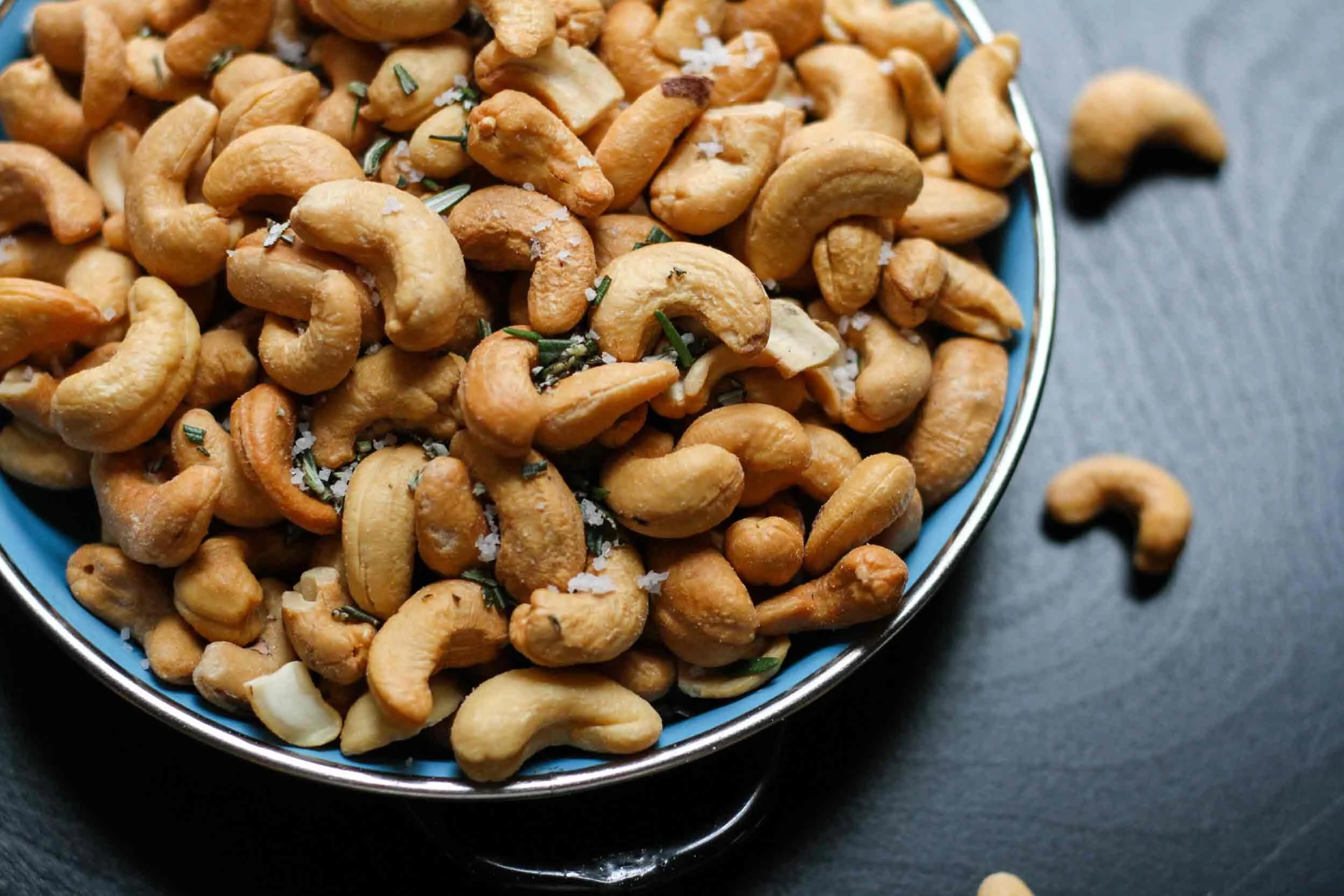Cashews
Premium bulk cashews for wholesalers, distributors, suppliers and importers
CASHEWS: A SHORT INTRODUCTION
A close relative of poison ivy, mango, and pistachios, the cashew plant originates from the Caribbean Islands, and northern South America, especially northeastern regions of Brazil, where it is part of tropical rainforest ecosystems. Portuguese explorers and colonists discovered and transported the cashew to other parts of the world, and it is now a cultivated plant in India, Vietnam, the Ivory Coast and Nigeria, which produces more than 1.9 metric tons of cashew nuts every year.
The cashew is a tropical evergreen plant that can reach up to 14 m (46 ft) in height, with ‘dwarf’ cashew trees, growing up to 6 m (20 ft), being more profitable, with earlier maturity and higher yields for over 30 years.
NUTRITIONAL FACTS
| NUTRIENT | UNIT | VALUE PER 100G |
|---|---|---|
| Water | g | 5.20 |
| Energy | kcal | 553 |
| Protein | g | 18.22 |
| Total lipid(fat) | g | 43.85 |
| Carbohydrates, by difference | g | 30.19 |
| Fiber, total dietary | g | 3.3 |
| Sugars, total | g | 5.91 |
Cashew nuts mainly contain “good” monounsaturated fats, the most important being oleic acid, which is also found in olive oil. They enhance skin protection, as they contain significant amounts of copper, an ingredient related to the formation of skin elastin and collagen. Cashews contain good quality amino acids, such as tryptophan, which is necessary for teenagers and children, for athletes and the for the elderly. They are a good source of natural fiber, contributing to a healthy bowel, creating a higher sense of fullness and improving the lipid profile. Cashews also have high contents of B complex vitamins, especially thiamine and vitamin B6, which help the metabolism, as well as vitamin E, which is a powerful antioxidant.
Just a handful of cashews is enough for a significant intake of necessary minerals and trace elements, such as phosphorus, magnesium, manganese, iron and zinc, while the antioxidants they contain protect the body against the harmful effect of oxidative stress.
GRADES
Quality classification for cashews can vary depending on industry standards and specific regions. Here is a commonly used grading system:
First Quality:
W210: Whole cashews with an average of 210 nuts per pound.
W240: Whole cashews with an average of 240 nuts per pound.
W320: Whole cashews with an average of 320 nuts per pound.
W450: Whole cashews with an average of 450 nuts per pound.
WB: Whole butts (large kernel pieces).
WS: Whole splits (split open kernels).
LWP: Large white pieces.
SWP: Small white pieces.
Second Quality:
LBW210: Large broken and whole mix with an average of 210 nuts per pound.
LBW240: Large broken and whole mix with an average of 240 nuts per pound.
LBW320: Large broken and whole mix with an average of 320 nuts per pound.
LBW: Large broken and whole mix.
SW210: Small broken and whole mix with an average of 210 nuts per pound.
SW2440: Small broken and whole mix with an average of 2440 nuts per pound.
SW320: Small broken and whole mix with an average of 320 nuts per pound.
SW: Small broken and whole mix.
SB: Splits (halves).
SS: Splits (halves and smaller).
LP: Large pieces.
SP: Small pieces.
Third Quality:
DW320: Dessert whole kernels with an average of 320 nuts per pound.
DW350: Dessert whole kernels with an average of 350 nuts per pound.
DW: Dessert whole kernels.
Fourth Quality:
DW2: Dessert whole kernels.
DW3: Dessert whole kernels.
Fifth Quality:
SW2: Scorched whole kernels.
SSW2: Scorched whole kernels with stains or discoloration.
SW3: Scorched whole kernels.
DW: Dessert whole kernels.
DWT: Dessert whole kernels.
Sixth Quality:
CS: Closed shells.
SK: Shells with kernels.
SK2: Shells with kernels.
TPN: Thin shells, partially open.
TPN2: Thin shells, partially open.
TPB: Thin shells, partially broken.
DW4: Dessert whole kernels.
Please note that grading systems and terminology may differ in different regions and markets. The above classification provides a general understanding of how cashews are graded based on quality criteria.
PACKAGING
The 50lb carton size is commonly used in the cashew industry for bulk packaging. It provides a convenient and efficient way to transport and store cashews in large quantities. The vacuum packing ensures that the cashews remain protected during transit, preventing spoilage and maintaining their taste and texture.
HARVEST
The harvest period for cashews can vary depending on the producing country. Here is a general overview of the harvest periods for some major cashew-producing countries:
India: Cashew harvest in India typically takes place from February to May, with variations depending on the specific region and climate.
Vietnam: Cashew harvest in Vietnam usually occurs from late February to May, with the peak harvest season in March and April.
Brazil: Cashew harvest in Brazil generally takes place from September to January, with variations depending on the specific region and climate.
Nigeria: Cashew harvest in Nigeria typically starts in March and can extend until July, with variations depending on the specific region and climate.
Ivory Coast: Cashew harvest in Ivory Coast usually occurs from February to June, with the peak harvest season between March and May.
Tanzania: Cashew harvest in Tanzania generally takes place from September to February, with variations depending on the specific region and climate.
Please note that these harvest periods are approximate and can vary based on factors such as weather conditions, tree maturity, and agricultural practices.
KEY POINTS
Comparison of Estimated World Cashew Production (2022-2023): The global cashew production has seen some significant changes from 2022 to 2023. While some countries like Côte d'Ivoire, Ghana, Burkina Faso, Guinea Conakry, Senegal, and Togo have seen an increase in production, others like India, Cambodia, Vietnam, and Benin have experienced a decrease. The overall world production has seen a slight decrease of 1.0%. This comprehensive table provides a detailed comparison of the cashew production in metric tons for each country, along with the percentage change from 2022 to 2023.
Comparison of Estimated World Cashew Production (2022-2023)
| Country | 2022 Production (MT) | 2023 Production (MT) | % Change |
|---|---|---|---|
| India | 675,000 | 650,000 | -3.7% |
| Cambodia | 670,000 | 650,000 | -3.0% |
| Vietnam | 450,000 | 350,000 | -22.2% |
| Côte d'Ivoire | 1,235,000 | 1,250,000 | +1.2% |
| Nigeria | 275,000 | 275,000 | 0% |
| Guinea-Bissau | 260,000 | 260,000 | 0% |
| Benin | 240,000 | 230,000 | -4.2% |
| Ghana | 200,000 | 235,000 | +17.5% |
| Burkina Faso | 130,000 | 150,000 | +15.4% |
| Guinea Conakry | 120,000 | 140,000 | +16.7% |
| Senegal | 85,000 | 100,000 | +17.6% |
| Togo | 60,000 | 90,000 | +50.0% |
| Gambia | 28,000 | 28,000 | 0% |
| Mali | 7,000 | 7,000 | 0% |
| Subtotal Western Africa | 2,640,000 | 2,765,000 | +4.7% |
| Subtotal Northern Hemisphere | 4,435,000 | 4,415,000 | -0.5% |
| Tanzania | 200,000 | 200,000 | 0% |
| Mozambique | 85,000 | 85,000 | 0% |
| Kenya | 5,000 | 5,000 | 0% |
| Subtotal Eastern Africa | 290,000 | 290,000 | 0% |
| Brazil | 147,200 | 115,000 | -21.9% |
| Indonesia | 100,000 | 100,000 | 0% |
| Subtotal Southern Hemisphere | 537,200 | 505,000 | -6.0% |
| Others | 55,000 | 55,000 | 0% |
| World Total | 5,027,200 | 4,975,000 | -1.0% |
TOP PRODUCING COUNTRIES
The top producing countries of cashews globally include:
Vietnam: Vietnam is the largest producer of cashews, accounting for a significant portion of the world's cashew production. The country's favorable climate and extensive cultivation areas contribute to its high production volumes.
India: India is a major producer and consumer of cashews. The country has a long history of cashew cultivation and processing, with regions like Kerala, Karnataka, and Goa being prominent cashew-growing areas.
Ivory Coast (Côte d'Ivoire): Ivory Coast is one of the largest cashew-producing countries in West Africa. The country benefits from suitable agro-climatic conditions for cashew cultivation and has made significant contributions to the global cashew market.
Nigeria: Nigeria has a strong presence in the global cashew industry and is known for its substantial cashew production. The country's vast agricultural land and favorable climate support cashew cultivation on a large scale.
Brazil: Brazil has been steadily increasing its cashew production and is considered one of the leading cashew-producing countries in the Americas. The northeastern region of the country, particularly the state of Ceará, is renowned for its cashew orchards.
Tanzania: Tanzania is a prominent cashew producer in East Africa. The country's suitable climate and land availability contribute to its cashew cultivation, with regions like Mtwara and Lindi being key production areas.
Guinea-Bissau: Guinea-Bissau is a significant cashew producer in West Africa, known for its high-quality cashews. Cashew production plays a vital role in the country's economy, providing employment and income for many people.
Other notable cashew-producing countries include Mozambique, Benin, Indonesia, and Cambodia. The cashew industry is dynamic, and production levels can vary from year to year based on factors such as weather conditions, market demand, and agricultural practices.
India, Vietnam & the West Coast of Africa
are the main sources of Cashews
Cashews growing at different stages
Chicken & Mango salad with Cashews
Mixed nut healthy crackers








